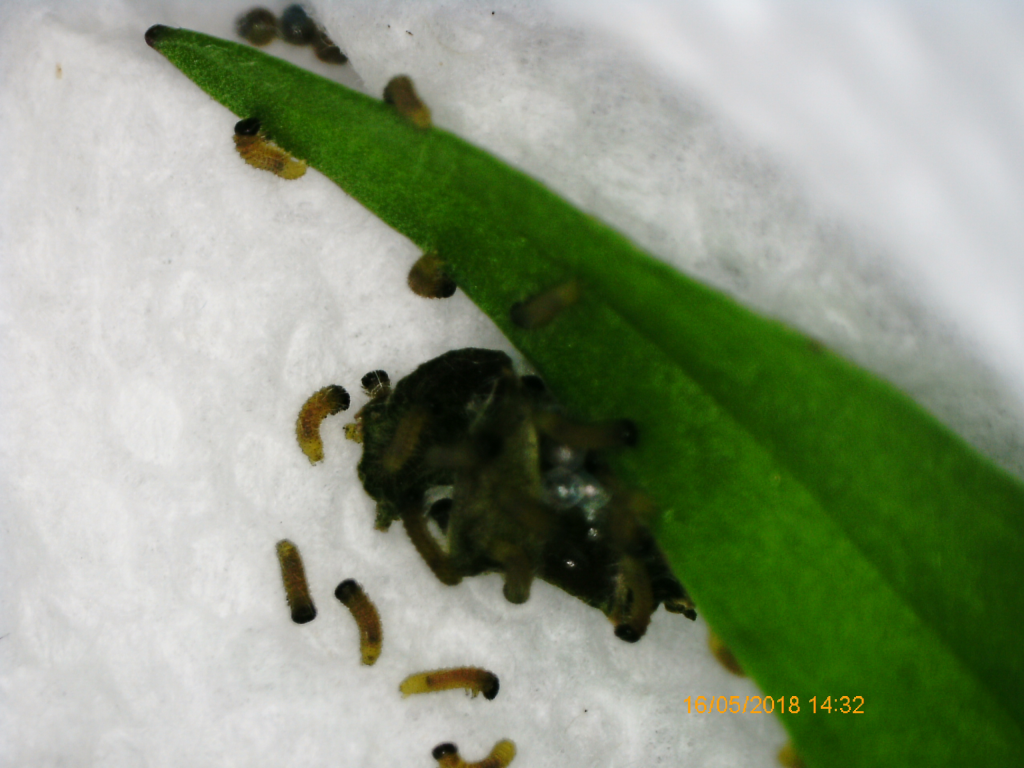By Karen Hall, June 2023
In May, the Ecological Education (EE) team began managing a captive-rearing laboratory for the endangered Taylor’s Checkerspot butterfly (TCB) at Coffee Creek Correctional Facility (CCCF). You read that right—a butterfly lab within the prison—and work on an endangered species, no less! Incarcerated crew members in the medium facility already work with the Ecological Education program to grow the plant narrowleaf plantain (Plantago lanceolata) to feed Taylor’s Checkerspot butterfly larvae as they grow. A back up supply of narrowleaf plantain and hookedspur violet (Viola adunca)—the latter of which serves as food for the threatened Oregon Silverspot butterfly—are grown by crew members in the minimum facility.
This captive-rearing lab was built in 2017 from the combined efforts of Chad Naugle and others at CCCF, US Fish and Wildlife service (USFWS) staff, and Ronda Naseth, USFWS butterfly contractor. Naseth is already a full-time animal husbandry expert at the Oregon Zoo, and her expertise has been invaluable as we begin to manage this fascinating program! The lab has added over 9,000 butterfly larvae, pupae, and several TCB butterflies to the world since its founding.

How does a laboratory function inside a prison, you might ask? Very well, really. The laboratory room is a small classroom—with whiteboards, desks and bulletin boards hosting important butterfly information (lifecycle, identification photos, etc.). Two rows of shelving make space for the small containers that house butterflies on narrowleaf plantain, and then eggs and larvae at various stages of growth.
Humidity, temperature, and lighting are all tightly controlled and recorded. The whiteboards serve for conveying task lists, milestones, and a few guidelines, though the procedures manual for this work takes more space than a whiteboard allows. A non-connected computer sits to the side, where data gathered can be entered and compared with results from previous years. A celebratory fabric banner sewn by prison industries hangs in the middle of the room, and is decorated with flowers and many embroidered Taylor’s Checkerspot butterflies—an aspirational addition.
Just underneath and outside the laboratory windows are storage containers for overwintering larvae, currently empty. The windows themselves frame rows of the riotous leaves of narrowleaf plantain in the yard where the Plantago crew works. Yes, crews are growing a weed in rows (and outside rows)!

Prison officials worked together with Naseth to recruit and retain butterfly crew members. The positions in the lab are highly coveted, but the turnover is low. The depth of knowledge that crew members have about captive rearing is pretty impressive! In many ways, the crew is self-sustaining. Our job is to provide oversight and access to the education they need to continue the work. We also work to bring in inspirational lessons—to keep them accountable, knowledgeable, and motivated to do their best with the ‘bugs’. In my last visit with the crew, we had some highly detailed discussion on the nutrients that narrowleaf plantain might be providing the larvae, compared to what the Taylor Checkerspot butterfly’s other known host plant—Golden paintbrush (Castilleja levisecta)—might have provided. This team’s thirst for knowledge is like a butterfly in pursuit of nectar!
The Ecological Education team came on board about the same time that gravid (with eggs) female butterflies arrived from the field. The spring was hard on Taylor’s Checkerspot butterflies this year, so we received fewer than normal. Within days of arriving, the butterflies were weighed, assigned matrilineal number, fed, and placed in containers with narrowleaf plantain. As eggs were laid, they were transferred to small, clear cups with one or two leaves of narrowleaf plantain.
The plant crew works hard to find leaves that are still soft and lacking a hard epidermis—tiny larvae can’t yet bite through tougher plant tissues. As the larvae hatch, they undergo one of six ‘instar’ stages. These are developmental stages marked by growth out of an exoskeleton. As the weeks go by, crew members keep us—and each other—informed of any changes. They work closely with the Plantago crew to put in ‘orders’ for leaves (by length) at least twice a week. Data connected to specific matrilineal lines is collected from the start, including: the numbers of butterflies, eggs, larvae, dates that these developmental stages occurred. Temperature, lighting, and humidity regimes are noted so that when problems arise, solutions can be quickly found and implemented.

As larvae transition through their fifth instar, they begin to eat slower in preparation for diapause—a slowed growth stage for overwintering. At this point, they leave the lab and move to the outdoor storage containers where temperature, humidity and movement are monitored regularly. In January or February (depending on weather), the crew begins to note increased movement in the caterpillars. We coordinate with USFWS to determine a wake-up date. The crew bases this decision partly on observations of the butterfly in the world outside prison. The crew then works to bring the larvae back into the lab, lightly feeding them, and help them advance to the sixth instar or pupation stage—at which point, they are released to known habitat for the butterfly.

Normally, we hold certificate celebrations for crew members (those who grow the plants and those who raise the butterflies) seasonally. The certificates state the types of training and the tasks completed by crew members—a way they can demonstrate their ecological work upon release. In a perfect world, we would hold this celebration at the same time as the release of larvae into the wild—a cheer for the future success of these crew members and the endangered butterfly they are helping to save! Inasmuch as prisons represent spaces where the impacts of past and current environmental harms are evident, we are creating a system that can promote flourishing and wellbeing for the human and non-human worlds. The metaphor of metamorphosis made real in a prison—what better space to educate, inspire and offer opportunity for change?
Thank you to the Coffee Creek Correctional Facility, the U.S. Fish and Wildlife Service, and our partners across the Pacific Northwest for helping to make this captive-rearing project possible.